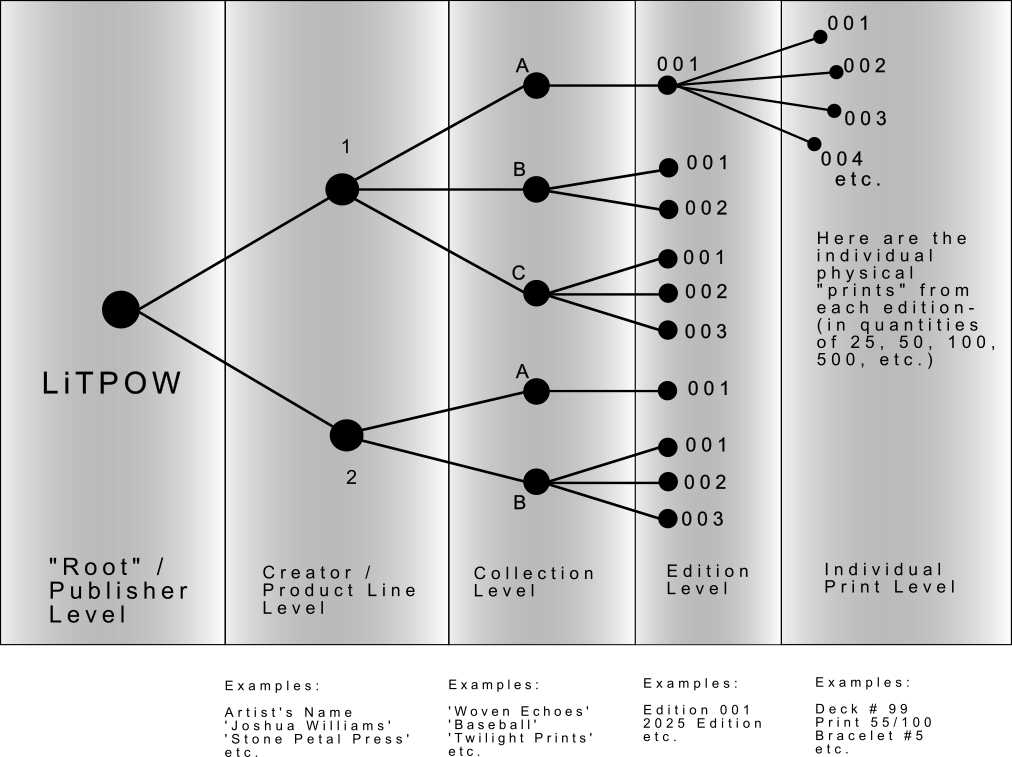The Publishing Chain: From Root to Print

When people think about publishing, they often imagine books, albums, or artworks being released to the public. But publishing is bigger than that. At its core, publishing is about making a statement public — something you can point to and say: this came from me, and here’s the proof.
The problem is that in the digital era, trust is fragile. Files can be copied. Identities can be faked. Products can be counterfeited. Anyone can publish anything, but how do you know what’s real?
That’s where the Publishing Chain comes in.
Transparent. Secure. Permanent.
The Publishing Chain leverages Bitcoin. Not as a currency, but as a data ledger. Bitcoin’s ledger is a public record, timestamped and immutable. Once data is written there, it cannot be altered or erased. That makes it a natural foundation for publishing in a way that’s transparent, secure, and permanent.
At the heart of the Publishing Chain is what I call the root transaction. This is the first entry, the anchor. It declares: “Here is the origin. Here is the publisher’s key.” From this root, every future release (whether a statement, an edition, or a physical artwork) can be traced back to its source.
From Root to Branches
The publishing chain grows outward like a tree, with each layer forming a branch:
- Root / Publisher – This is the business or entity that establishes the chain. LiTPOW handles this role. To view LiTPOW's root, please see our Root Declaration
- Creator / Product Line – The individual artist or line of work. For example: I (Joshua Williams) am the creator of the baseball game I recently published. Another creator might be an artist or artisan creating unique and valuable works.
- Collection – A thematic body of work. For me, “Baseball” is one collection. For another artist, it might be “Moonlit Prints.”
- Edition – A release within that collection. For example, “Edition 001” of the Baseball game, or “2025 Edition” of Moonlit Prints.
- Individual Print / Product – Each physical item — each deck of cards, every art print, every handcrafted bracelet or handbag.
Each level is connected through transactions on the Bitcoin ledger. Each item can be verified as authentic, because its record traces back through the Edition, the Collection, the Creator, and finally the Root.
Making It Real
Let’s say you buy a limited run of art prints from an artist. You receive Print #12 of the 2025 Moonlit Edition. On the surface, it’s just a beautiful print. But behind the scenes, that print is tied to a specific entry on the Bitcoin ledger.
- The publisher’s root proves the authenticity of the system.
- The creator level confirms the artist’s identity.
- The collection shows which body of work it belongs to.
- The edition specifies the release.
- And the individual print — your print — is its own transaction, permanently recorded.
That means you, or anyone else, can verify: this isn’t a copy, this isn’t a knock-off. It’s authentic, and the chain of trust is public. LiTPOW makes this simple.
Digital Signatures and Ownership
At the core of this system are digital signatures. When a publisher or creator issues a release, it’s signed with their private key. Anyone can use the corresponding public key to verify that signature. The math cannot be forged.
This is trust that doesn’t depend on branding or reputation alone. It’s trust that anyone can check for themselves.
A Trust Graph, Built on Math
Over time, this publishing chain forms a trust graph. Each new edition, each new print, each new statement grows the graph outward from the root. The result is a living map of a creator’s publishing life — one that’s traceable, verifiable, and permanent.
And because this proof is written to Bitcoin, it’s not a story that can be erased or manipulated. It’s a public record, forever.
Why It Matters
For creators, this system means confidence: your work can’t be counterfeited without it being obvious. For audiences, it means clarity: if you want to know what’s real, you can easily check the chain using LiTPOW's tools.
From the root to every branch that follows, the Publishing Chain makes authenticity transparent. It ensures that every physical item — every deck, every print, every piece of art — is part of a lineage that can’t be faked.
This is publishing as it was always meant to be: public, durable, and provable.
LiTPOW helps authentic creators protect the real value of their work by making it easy to prove the authenticity of real items. Traceable, permanent, secure. Simple. Questions? Contact Us:
Let’s talk about how LiTPOW can help you verify and protect your work — or the work of the artists you support.